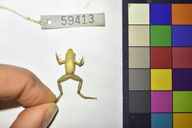|
Epipedobates machalilla (Coloma, 1995)
| family: Dendrobatidae subfamily: Colostethinae genus: Epipedobates |
 © 2018 Rebecca Tarvin (1 of 3) |
|
|
|
Description Epipedobates machalilla can be distinguished from other species in the genus by its dark coffee-color and its non-venomous nature. Epipedobates machallila appears similar to Hyloxalus breviquartus, H. cevallosi, and Colostethuys fugax, and in that they all have solid, oblique lateral stripes, unmarked bellues, and rudimentary or absent membranes between the digits on the foot. However, E. machallila differs from C. fugax in that it is slightly larger and has an X-shaped mark on the scapular region. Epipedobates machalilla also differs from H. breviquartus and H. cevallosi in that the males have a swollen third digit on the foot (Coloma 1995). In life, Epipedobates machalilla appears pale olive-tan on its dorsal surfaces, and have a dark brown X marking on the scapular region. The flank is dark brown to black. The upper lip is creamy yellow with pinkish shades. The oblique lateral strip is either creamy yellow or white with pale pinkish permeations projected anteriorly. The arms are pale orange and the dorsal surfaces of the legs are pale brown. The posterior surfaces of the thighs are yellowish orange. There is a discrete orange mark in the groin region. The ventral surfaces are cream color. The iris is gold color (Coloma 1995). In preservative, the dorsal surfaces appear gray with dark brown marks. The oblique lateral strip is white. Black bands that extend from the tip of the snout to groin appear on the flanks. The upper lip is white. Two white stripes can be seen on the thighs. The posterior surface of the thigh is brown, decorated with small white spots. Transverse brown bars are present on the dorsal surfaces of the fingers (Coloma 1995). There is significant geographic variation; with some specimens presenting with a narrow middorsal black stripe and in some specimens the white ventrolateral strip is indistinct. Other variants include individuals with small, scattered marks on the throat and individuals with two spots in the mental region (Coloma 1995). Distribution and Habitat Country distribution from AmphibiaWeb's database: Ecuador
The species has also been observed to live in sympatry with Hyloxalus awa in the Mache Chindul moutains within the Cordillera de la Costa range and with Hyloxalus infraguttatus in the Chimbo River basin and Chongon Colonche range (Coloma 1995; CITES 2013). Life History, Abundance, Activity, and Special Behaviors In comparison to those of the Dendrobates genus, the eggs of E. machalilla are the smallest and least pigmented (CITES 2013). Trends and Threats The main, direct threat to E. machalilla is habitat deforestation in Ecuador due to expansion of agriculture (crops, livestock), logging, exploration and exploitation of non-renewable resources, construction of new roads, and installations of hydroelectric plants and dams (Coloma et al. 2004). It is speculated that 95% of the coastal forests have been degraded because of these types of agricultural conversions and urbanization. Some of the indirect threats to E. machalilla include temperature changes and the blooming human population in Ecuador. Because of the growing human population, there is more demand for goods and services that use the Ecuador’s natural resources, which is also shared with E. machalilla (CITES 2013). Because of the threats to E. machalillia, it is included in the Strategic Plan for the Conservation of Amphibians in Ecuador (Coloma 2011). The species can be found in the public protected areas of Machalilla National Park and in the private protected areas of Cerro Blanco Protected Forest (Coloma et al. 2004). Possible reasons for amphibian decline General habitat alteration and loss Comments The subspecies name machalill refers to the Machalilla National Park in which it is found (Coloma 1995). E. machalilla is used for embryonic development studies (CITES 2013).
References
CITES (Convention on International Trade in Endangered Species of Wild Fauna and Flora). Accessed April 2013 from http://www.cites.org/eng/cop/16/prop/E-CoP16-Prop-39.pdf Coloma, L. A. (1995). Ecuadorian Frogs of the Genus Colostethus (Anura: Dendrobatidae). Museum of Natural History, University of Kansas, Lawrence, Kansas. Coloma, L. A., Ron, S., Yánez-Muñoz, M., Cisneros-Heredia, D., and Almendáriz, A. (2004). Epipedobates machalilla. In: IUCN 2012. IUCN Red List of Threatened Species. Version 2012.2. www.iucnredlist.org. Downloaded on 23 April 2013. Del Pino, E., Ávila, M. E., Pérez, O., Benitez, M. S., Alarcón, I., Noboa, V., and Moya, I. M. (2004). “Development of the dendrobatid frog Colostethus machalilla.” International Journal of Developmental Biology, 48, 663-670. Originally submitted by: David Wong (first posted 2013-06-07) Edited by: Ann T. Chang (2013-06-12) Species Account Citation: AmphibiaWeb 2013 Epipedobates machalilla <https://amphibiaweb.org/species/1581> University of California, Berkeley, CA, USA. Accessed Jun 16, 2025.
Feedback or comments about this page.
Citation: AmphibiaWeb. 2025. <https://amphibiaweb.org> University of California, Berkeley, CA, USA. Accessed 16 Jun 2025. AmphibiaWeb's policy on data use. |



 Map of Life
Map of Life